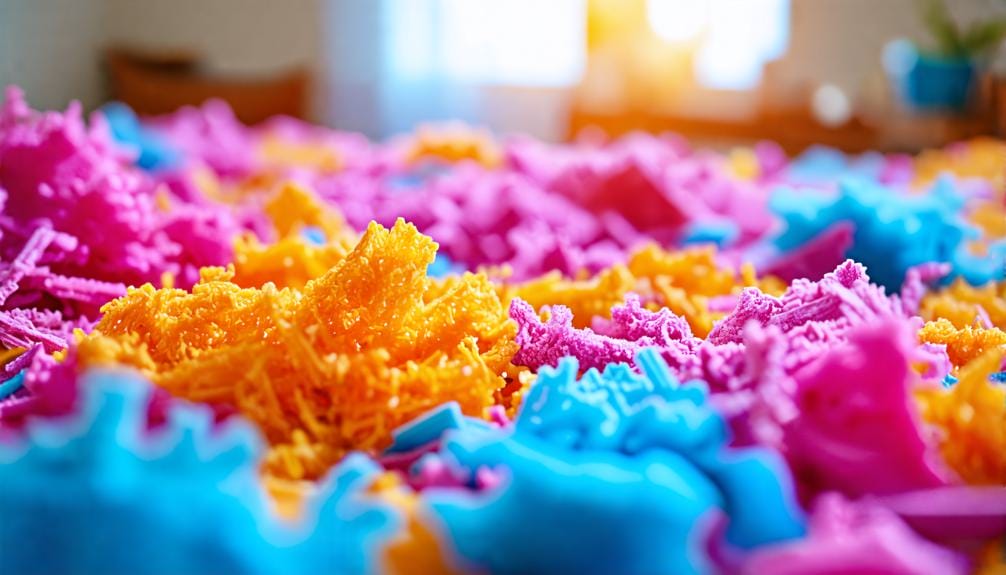How Much Shredded Foam Do I Need? Discover the Answers
When you are tackling a project that requires shredded foam, it’s essential to pinpoint the right amount for your needs. You might be surprised at how different applications, from bean bags to cushions, call for varying quantities. Comprehending the specific dimensions and your comfort preferences can greatly impact the final outcome. But what happens if you miscalculate or if your foam compresses over time? Let’s explore the factors that influence your decision and how to make certain you get it just right.
What is Shredded Foam

Shredded foam is a flexible filling material made from small pieces of foam, ideal for cushions, pillows, and stuffed toys. If you’re searching for a foam filler, shredded foam is a top choice due to its adaptability and comfort. It provides excellent support by molding to your body shape, making it perfect for sitting or lying down.
One key advantage of shredded foam is its ability to retain its shape over time. Unlike traditional foam, this high-quality material breaks down more slowly, offering durability and longevity for your items. It combines softness and firmness, making it suitable for various uses.
Shredded foam also allows for easy customization. You can adjust the amount to achieve your preferred level of comfort and support. Whether creating a unique pillow or re-stuffing an old cushion, determining the right amount of shredded foam is crucial. This versatile filler lets you craft your ideal comfort solution, ensuring you enjoy every moment spent lounging or resting.
Why Use Shredded Foam for Bedding
Shredded foam bedding offers a perfect mix of comfort and support, making a noticeable difference in your sleep quality. These foam pieces adapt to your body shape, providing a level of comfort that traditional mattresses often can’t match. They help relieve pressure points, so you wake up without aches and pains.
If you have allergies, shredded foam is a smart choice. Many options are hypoallergenic, which means fewer allergens to disrupt your sleep. Plus, you can adjust the fill to suit your preference, whether you like a firmer or softer feel.
High-quality memory foam shreds promote airflow, keeping your sleeping environment cool and comfortable. You won’t have to deal with overheating during the night, a common issue with solid foam mattresses.
How to Measure Shredded Foam for Bedding

To figure out how much shredded foam you’ll need for your bedding, first measure the dimensions of your pillow or mattress. For pillows, measure the length, width, and desired thickness. For mattresses, measure the length, width, and depth.
Next, calculate the volume. For pillows, multiply the length by the width and height. For mattresses, use the same formula, including the depth. This calculation gives you the total cubic inches or cubic centimeters needed for your shredded foam.
Keep in mind that shredded foam can compress over time, so add a little extra to your measurements. For pillows, fill them until they’re slightly overstuffed to allow for settling.
Once you know the volume, convert it to a weight measurement since shredded foam is typically sold by weight. This step ensures you get enough foam to fill your bedding comfortably.
With these precise measurements, you’ll have the right amount of foam for your needs.
What Are the Recommended Amounts of Shredded Foam
Understanding how much shredded foam you need for your bedding or furniture projects can make a big difference in achieving comfort and support. Here are some practical guidelines to help you decide:
For a standard-sized bean bag, about 3 to 4 cubic feet of shredded foam works well.
For a large bean bag chair, aim for 5 to 6 cubic feet.
For smaller projects like cushions, 1 to 2 cubic feet is usually enough.
If you’re using filler beads, start with 2 to 3 bags to ensure ample support, and adjust as needed.
Shredded foam is versatile, whether for a comfy bean bag chair or refreshing your bedding.
The key is to match the amount to your personal comfort needs and the specific project.
By following these recommendations, you can achieve a plush, supportive experience.
Always test the fill and make adjustments to get the perfect feel.
Factors Influencing the Amount of Shredded Foam Needed

Several factors determine how much shredded foam you’ll need for your project, including the item’s size, intended use, and comfort preferences.
First, consider the size of the item; larger items usually require more shredded foam to fill and retain their shape. For cushions or pillows, think about the desired firmness. Foam density greatly impacts comfort and support.
The intended use is also crucial. Decorative pieces may need less foam than items subject to regular use, like dog beds or gaming chairs. Lightweight materials are good for portability, while heavier options provide more stability.
Where to Buy Shredded Foam
You can easily find shredded foam at various retailers, both online and in-store, making it simple to choose an option that fits your needs. Whether you’re making a foam bean bag or need high-quality memory foam for another project, there are plenty of choices available.
Here are some places to consider:
- Online Marketplaces: Websites like Amazon and eBay offer a range of foam types and often include customer reviews to help you decide.
- Craft Stores: Local craft stores usually stock different types of foam for DIY projects, including shredded foam.
- Specialty Foam Retailers: These stores focus on foam products and offer high-quality memory foam and shredded foam in bulk.
No matter where you buy, make sure you’re getting the right type for your needs.
Whether you need shredded foam for comfort or durability, knowing where to shop is the first step to completing your project.
What to Do If You Have Excess Shredded Foam

Got extra shredded foam? Put it to good use instead of throwing it away. Repurposing shredded foam is a smart, eco-friendly way to tackle home projects and save money.
First, consider making custom cushions for your chairs or outdoor furniture. Shredded foam can transform hard seats into cozy spots, saving you from buying new cushions.
Another idea is to fill a bag with shredded foam to create a comfy pet bed. Your furry friend will love the comfort, and you’ll clear out some of that foam clutter.
If you’re into crafting, shredded foam is perfect for stuffed toys or decorative pillows. It’s lightweight, easy to handle, and adds a fun touch to your projects.
Lastly, think about donating any excess shredded foam to local schools or community centers. They might use it for art projects or sensory play in classrooms, benefitting kids and reducing waste.
Frequently Asked Questions
Can I Mix Different Types of Shredded Foam?
Yes, you can mix different types of shredded foam! Just guarantee they have similar densities and properties. This way, you’ll maintain comfort and support, creating a balanced feel for your project or application.
How Do I Clean Shredded Foam Bedding?
To clean shredded foam bedding, you should spot clean stains using a damp cloth and mild detergent. If necessary, you can air dry the foam outdoors, ensuring it’s completely dry before using it again.
Is Shredded Foam Hypoallergenic?
Yes, shredded foam is generally hypoallergenic. It resists dust mites and mold, making it a great choice for allergy sufferers. Just guarantee you choose high-quality foam to maximize its hypoallergenic properties and comfort.
What Is the Lifespan of Shredded Foam?
The lifespan of shredded foam typically ranges from three to five years, depending on usage and quality. You should regularly check for wear and replace it when it starts losing its shape and support.
Can Shredded Foam Be Recycled?
Yes, you can recycle shredded foam, but it depends on local recycling programs. Check with your waste management facility to see if they accept it. Proper disposal helps reduce landfill waste and supports sustainability efforts.
Conclusion
To sum up, figuring out how much shredded foam you need is essential for achieving the right comfort and fit for your project.
By considering the size, intended use, and your personal preferences, you can guarantee you get the right amount.
Don’t forget to measure accurately and account for foam compression over time.
Whether you’re creating bedding, cushions, or furniture, you’re now equipped with the knowledge to make your project a success!
Happy crafting!
